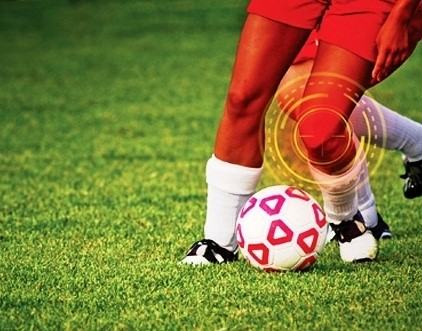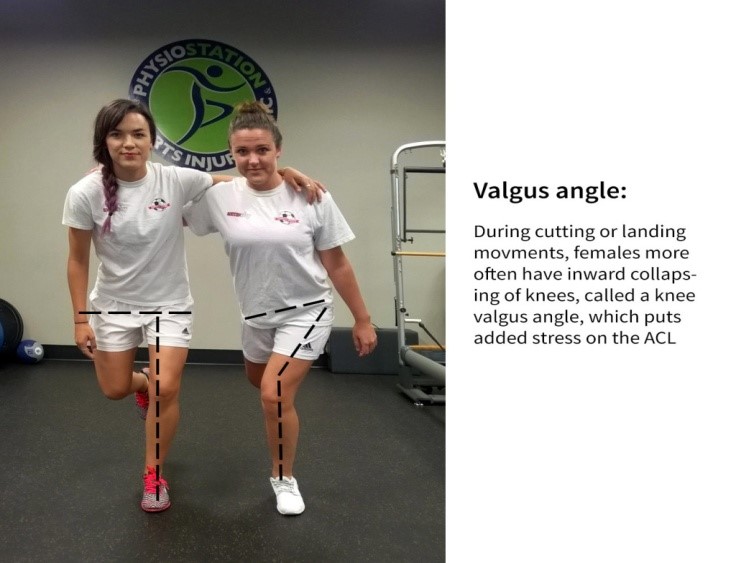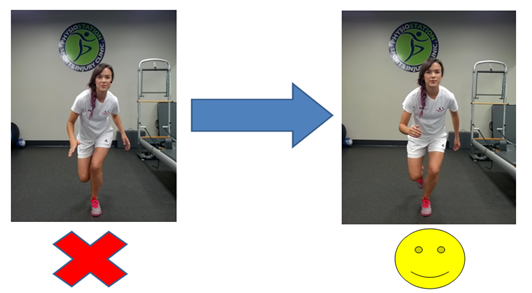Anterior cruciate ligament (ACL) tears have become an EPIDEMIC among female athletes. Research has shown that female athletes are 8x more likely than males to suffer from an ACL injury. Over the past number of years the amount of young athletes sustaining ACL injuries has rapidly increased.
Despite the many training programs and abundance of information available, ACL injuries rates are continuing to rise because there is a lack of screening for specific movement patterns and adequate strength.
Research has shown that up to 88% of ACL injuries can be prevented by early screening, education, and a sports specific agility program. Programs such as Physiostation and Sports Injury Clinic’s KneeSTRONG focuses on proper movement techniques and increasing strength of specific muscles in contrast to programs focusing only on strength.
What does the ACL do?
 The ACL is one of the four main ligaments in that stabilize the knee. It role is to prevent knee instability by preventing the shin bone (tibia) from sliding forward in relation to the thigh bone (femur). It also prevents hyperextension of the knee and protects the shock absorbers (mensci) from damage that might occur when pivoting, cutting or jumping.
The ACL is one of the four main ligaments in that stabilize the knee. It role is to prevent knee instability by preventing the shin bone (tibia) from sliding forward in relation to the thigh bone (femur). It also prevents hyperextension of the knee and protects the shock absorbers (mensci) from damage that might occur when pivoting, cutting or jumping.
70% of ACL injuries are the result of non-contact activities such as soccer or basketball. Improper movement patterns put female athletes at higher risk for tearing the ACL.
Why are females at a higher risk for ACL injuries?
Females use their muscles differently than males when landing a jump, moving side to side or decelerating which may put them into dynamic knee valgus a position that can cause an ACL tear.
The soccer player on the right in the picture shows a valgus knee; a position where the knee comes inward in relation to the foot and the hip.
Females tend to land on a straighter knee, with gluteal and hamstring muscles not being utilized as much as the quadriceps during landing. This movement pattern has been shown to increase forward movement of the tibia and the risk of ACL injury.
Females frequently have one leg stronger than the other which is common among soccer players when comparing the stance and kicking legs. This difference in strength can cause the body’s centre to shift away from the base of support where the foot is planted which is associated with increased risk of ACL injury.
Why is it important to screen for risk of ACL injury?
Fortunately, these factors that put females at a higher risk for ACL injuries can be modified. By examining athletes’ movement patterns, physiotherapists and other movement specialists can determine which movements may be increasing the risk of an ACL injury.
Screening for dynamic valgus knee angle during jumps or pivoting movements, differences in strength between sides, and weaknesses in muscles which stabilize the knee are all important in determining which exercises and agility training strategies are appropriate for individual athletes.
KneeSTRONG and Prevention of ACL Injuries
Prevention programs including agility and strength training were shown in the research to have a 72% decrease in ACL injuries after administration.
Physiostation and Sports Injury Clinic offers a three part program called KneeSTRONG to prevent ACL injuries in young athletes.
KneeSTRONG includes
• Functional movement screening assessment performed by a Physiotherapist
• Individualized exercise program shown by a Kinesiologist
• Follow up assessment by a Physiotherapist to monitor training progress
The program includes education about the avoiding the knee valgus position and other positions that put the ACL at risk for injury. It focuses on proper movement patterning during sports specific movements as well as strengthening of muscles around the hip and knee to improve balance and knee control.
With the overwhelming impact that ACL injuries has on young athletes it is important to utilize the resources available to screen and prevent ACL injury in young athletes who are at highest risk of injury.
If you have any questions regarding the information please feel free to contact Kadi Nicholson, a physiotherapist at Physiostation and Sports Injury Clinic. If you would like to set up a KneeSTRONG assessment for you or your child please call 604.372.0808 to book with any of the physiotherapists at Physiostation and Sports Injury Clinic.
References
Myer GD, Sugimoto D, Thomas S, Hewett TE. The influence of age on the effectiveness of neuromuscular training to reduce anterior cruciate ligament injury in female athletes: a meta-analysis.Am J Sports Med. 2013;41(1):203-215.
Physiostation and Sports Injury Clinic’s KneeSTRONG program
Prevention of ACL Injuries in Adolescent Female Athletes By Aisha Dharamsi MD, Cynthia LaBella MD
http://contemporarypediatrics.modernmedicine.com/contemporary-pediatrics/content/tags/acl-injury/prevention-acl-injuries-adolescent-female-athletes
